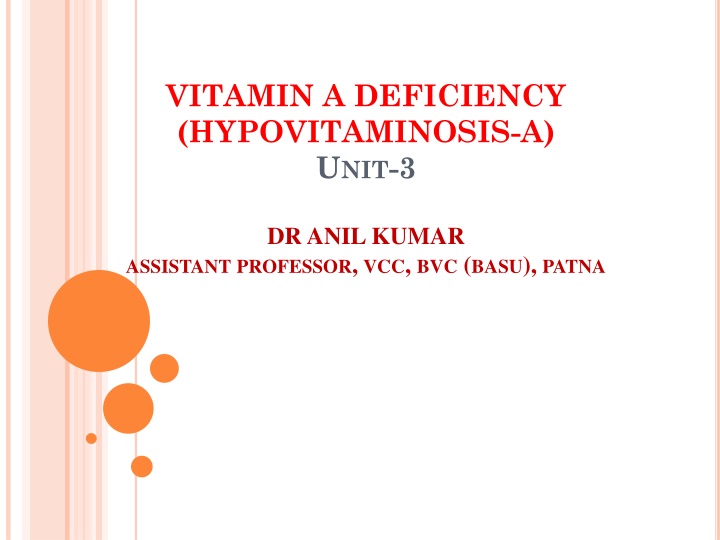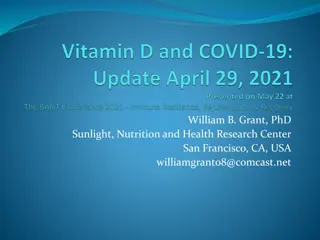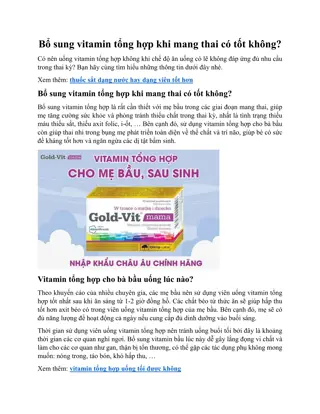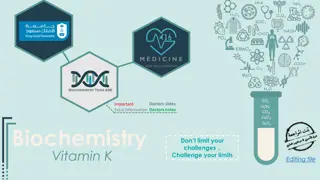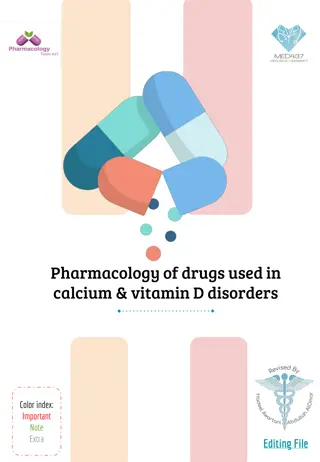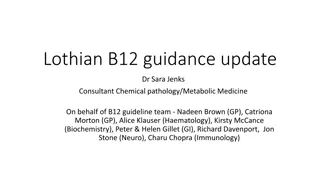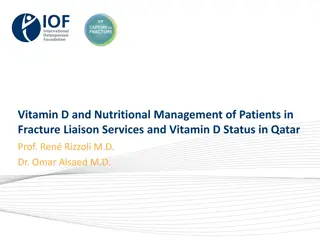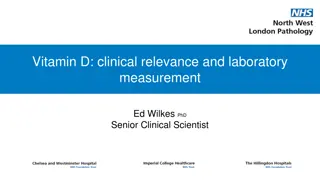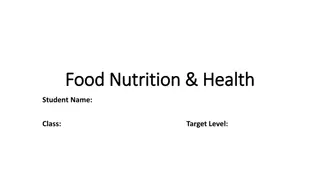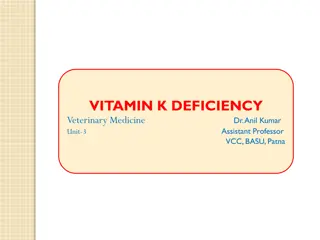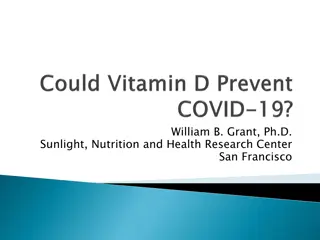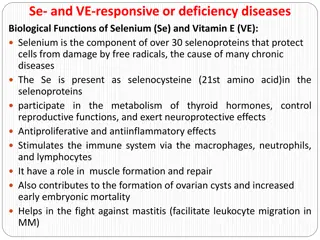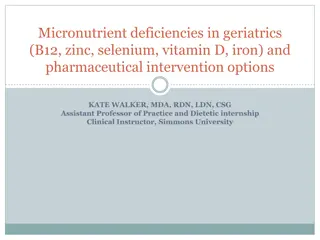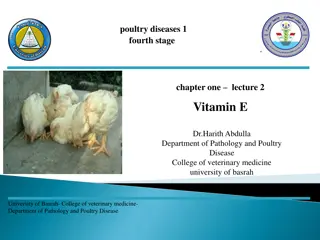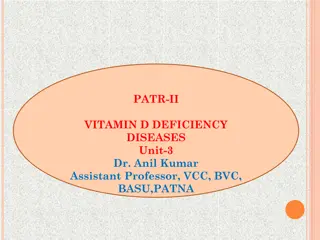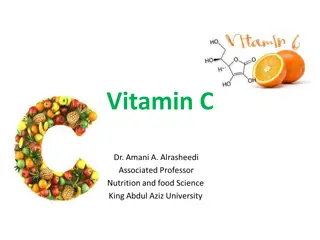Vitamin A Deficiency: Causes, Symptoms, and Management
Retinol, the alcohol form of vitamin A, is essential for vision, bone growth, and epithelial tissue maintenance. Hypovitaminosis-A can result from inadequate intake or absorption issues, leading to night blindness, keratinization, weight loss, and infertility. Factors contributing to deficiency include diet, liver or intestinal diseases, and environmental conditions. Adequate supplements, such as carotene and vitamin A, can help prevent and manage deficiency.
Download Presentation

Please find below an Image/Link to download the presentation.
The content on the website is provided AS IS for your information and personal use only. It may not be sold, licensed, or shared on other websites without obtaining consent from the author.If you encounter any issues during the download, it is possible that the publisher has removed the file from their server.
You are allowed to download the files provided on this website for personal or commercial use, subject to the condition that they are used lawfully. All files are the property of their respective owners.
The content on the website is provided AS IS for your information and personal use only. It may not be sold, licensed, or shared on other websites without obtaining consent from the author.
E N D
Presentation Transcript
VITAMIN A DEFICIENCY (HYPOVITAMINOSIS-A) UNIT-3 DR ANIL KUMAR ASSISTANT PROFESSOR, VCC, BVC (BASU), PATNA
INTRODUCTION: Retinol is the alcohol form of vitamin A. Vitamin A and the precursor carotenoids are rapidly destroyed by oxygen, heat, light, and acids. Presence of moisture and trace minerals reduces vitamin A activity in feeds Vitamin A is essential for: Dim light vision Normal bone growth and Maintenance of normal epithelial tissues The main site of vitamin A and carotenoid absorption is the mucosa of the proximal jejunum. Carotenoids are normally converted to retinol in the intestinal mucosa, but may also be converted in the liver and other organs, especially in yellow fat species.
An insufficiency in the ration or its defective absorption from the alimentary canal are the causative factors for hypovitaminosis-A. In young animals-- compression of the brain and spinal cord. In adult animals---the syndrome is characterized by night blindness, corneal Keratinization, pityriasis, defects in the hooves, loss of weight and infertility. EPIDEMIOLOGY: Primary vitamin A deficiency: Occurs in in groups of young growing animals on pasture or fed diets deficient in the vitamin or its precursors Housed cattle fed a ration containing little or no green forage Prolonged droughts
Maternal deficiency: A maternal deficiency of vitamin A can result in congenital hypovitaminosis-A in calves Carotene does not pass the placental barrier and a high intake of green pasture before parturition does not increase the hepatic stores of vitamin A in newborn calves, lambs, or kids, However, vitamin A in the ester form, (fish oils OR the parenteral injection) will pass the placental barrier in cows, and will cause an increase in stores of the vitamin in fetal livers. Ante-partum feeding of carotene and the alcohol form of the vitamin can cause an increase in the vitamin A content of the colostrum.
Adequacy of supplements: Carotene and vitamin A ----readily oxidized in the presence of unsaturated fatty acids. Heat, light, and mineral mixes increases the rate of destruction of vitamin A supplements in commercial rations. Secondary vitamin A deficiency: Chronic disease of the liver (Storage) or intestines (Conversion of carotene to vitamin A) A low phosphate diet has sparing effect on vitamin A requirements during drought periods. Chlorinated naphthalene interfere with the conversion of carotene to vitamin A Vitamins C and E help to prevent loss of vitamin A in feedstuffs and during digestion A high environmental temperature, a high nitrate content of the feed, reduces the conversion of carotene to vitamin A.
PATHOGENESIS: The major pathophysiological effects of vitamin A deficiency are as follows: Reduced Night vision Increase cerebrospinal fluid pressure due to impaired absorption of the CSF due to reduced tissue permeability of the arachnoid villi and thickening of the connective tissue matrix of the cerebral duramater and lead to syncope and convulsions in calves In-coordination of bone growth Atrophy of all epithelial cells, mostly in those types of epithelial tissue with a secretory as well as a covering function, lead to the clinical degeneration, xerophthalmia and corneal changes Embryological development defects signs of placental
CLINICAL FINDINGS: Night blindness (Inability to see in dim light/ loss of vision due to a failure of rhodopsin formation in the retina)earliest sign in all species except in pigs Xerophthalmia with thickening andclouding of the cornea,occurs only in thecalf Changes in the skin: A rough, dry coat with a shaggy appearance and splitting of the bristle tips inpigs is characteristic Heavy deposits of bran-likescales on the skin and Dry, scaly hooves with multiple, vertical cracks (Cattle) Dry, scaly hooves with multiple,vertical cracks are particularly noticeable (Horses).
Reduced reproductive efficiency Paralysis, Encephalopathy and Blindness occur at any age but most commonly in young, growing animals in all species except horses. The ocular form of hypovitaminosis-A occurs usually in yearling cattle (12-18months old) and up to 2-3 years of age. Blindness in both eyes during daylight, where both pupils are widely dilated and fixed and will not respond to light. The menace reflex is usually totally absent, but the palpebral and corneal reflexes are present. Congenital defects: Mostly seen in Piglets (complete absence of the eyes(anophthalmos), or small eyes (microphthalmos),incomplete closure of the fetal optic fissure, degenerative changes in the lens and retina, and an abnormal mesenchymal tissue in front of and behind the lens and calves (congenital blindness due to optic nerve constriction and encephalopathy). proliferation of
DIAGNOSIS: History (green feed or vitamin Asupplements are not being provided) Clinical findings The detection of papilledema and testing for night blind ness are the easiest methods of diagnosing early vitamin A deficiency in ruminants. Clinical pathology: Plasma vitamin Aof 20 micro g/dL are theminimal concentration for vitamin Aadequacy. Papilledema ( optic disc swelling that is caused by increased intracranial pressure) is an early sign of vitamin A deficiency which develops before nyctalopia and at plasma levels below 18 micro g/dL
TREATMENT: As a rule, 440 IU/kg BW is the dose used to treat the case. Cattle with theocular form of the deficiency and that areblind will not respond to treatment andshould be slaughtered for salvage. CONTROL: Dietary requirement The minimum daily requirement in all species is 40 IU of vitamin A/kg BW, which is a guideline for maintenance requirements Parenteral Injection: An alternative method to dietary supplementationis the 1M injection ofvitamin A at intervals of 50-60 days at therate of 3000-6000 IU/kg BW
In pregnant beef cattle the last injection should not be more than40-50 days before parturition to insure adequate levels of vitamin A in the colostrum. Ideally, the last injection should be given 30 days before parturition Hypervitaminosis-A Daily heavy dosing (about 100 times normal) of calves causes reduced growth rate, lameness, ataxia, paresis, exostoses on the planter aspect of the third phalanx of the fourth digit of all feet, and disappearance of the epiphyseal cartilage. Persistent heavy dosing in calves causes lameness, retarded horn growth and depressed CSF pressure.
